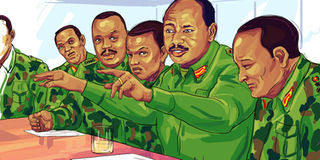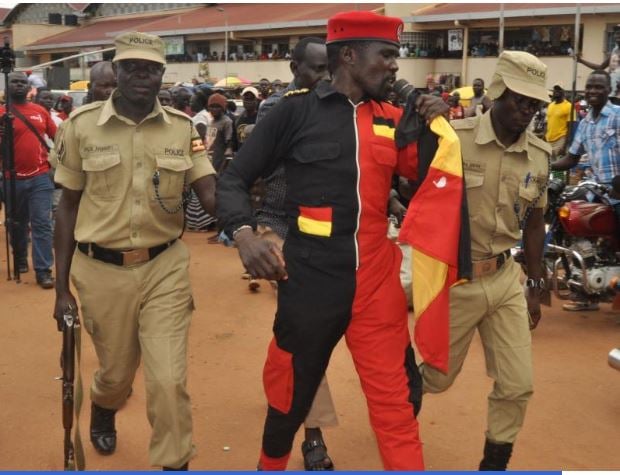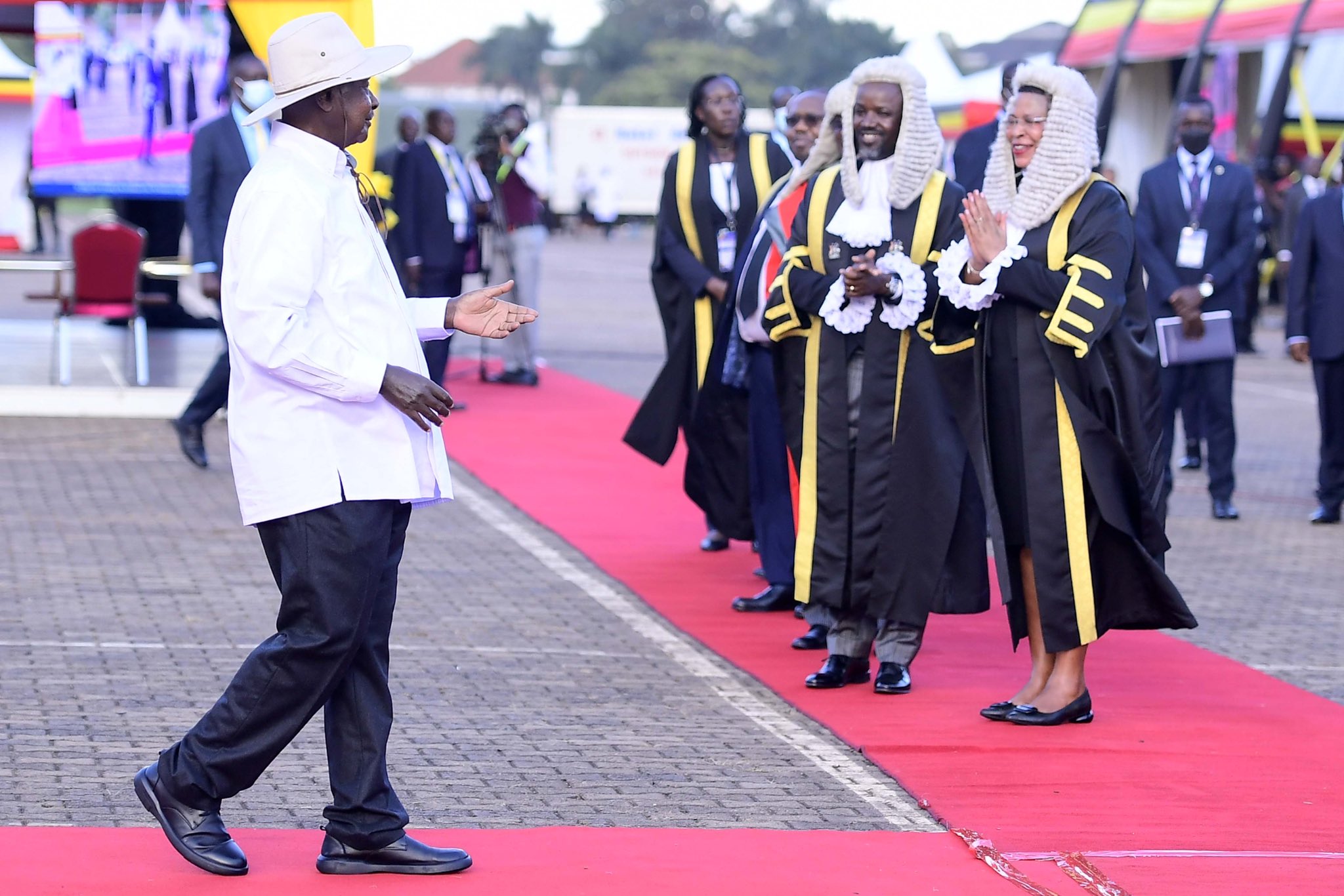Baganda put pressure on NRA to have Mutebi crowned

An illustration of President Museveni (right) chairing the Army Council on April 3, 1992, in Gulu District. ILLUSTRATION BY COSMAS ARINITWE
What you need to know:
Part III. During the inaugural swearing-in speech by Yoweri Museveni as President on January 29, 1986, three days after the capture of Kampala by the NRA rebels, enthusiastic traditional Baganda were disappointed when he did not mention the return of Prince Ronald Mutebi to Nnamulondo, the throne of Buganda Kingdom, writes Faustin Mugabe.
The Luweero war was fought on the pretext to restore political sanity in Uganda. Since the war was launched and largely fought in Buganda, sentiments about the restoration of Buganda Kingdom were running high when the National Resistance Army rebels (NRA) defeated the Uganda National Liberation Army (UNLA) and captured Kampala in January 1986.
They had fought a gruelling five-year guerrilla war against the Uganda People’s Congress (UPC) government of president Milton Obote who had in 1967 abolished kingdoms in Uganda.
Immediately after the war, traditional Baganda started calling on Prince Ronald Mutebi to return from London and succeed his father king Edward Muteesa II who was toppled in 1966 and died in exile in Britain in 1969.
Prince Mutebi had also since 1966 lived in Britain. Incredibly, some Baganda traditionalists referred to Mutebi as the Kabaka (king) of Buganda and not Omulangira (prince) even before he was crowned.
Where is our Kabaka?
With the overthrow of the leaders associated with the collapse of Buganda Kingdom and the army that had raked havoc on citizens, especially in Luweero, to Buganda it was time to rejoice. Now was the time to restore Buganda’s lost glory – and without any questions or delays according to them. This started soon after Yoweri Museveni had first been sworn-in on January 29, 1986, as the President of Uganda.
The “Twagala Kabaka waffe akomewo” (We want our king back) demand became the talk all over Buganda.
Although the anxiety among the Baganda to see Prince Mutebi back was raging high, some other people in the kingdom did not want him to return until an understanding had been reached between the Bataka Council of Buganda and the Uganda government. Patience was running out fast and tension was growing between monarchy officials at Mengo and the Uganda government.
Mutebi arrives in Kampala
On Thursday, August 14, 1986, Prince Ronald Mutebi arrived in Kampala. He had entered Uganda through Kenya. He crossed the border at Busia at 1:30pm having left Nairobi at exactly 6:30am in a private car. At the border, Mutebi was secretly received by an NRM envoy, commander Andrew Lutaaya (now retired brigadier), and driven to Kampala, arriving late at around 6pm due to the bumpy road.
Mutebi first stayed in Muyenga before he was driven to Koma-Mboga in Kawempe on Gayaza Road where he stayed for a while. Mutebi had stayed in Kenya since the beginning of the Nairobi peace talks between the NRA rebels and the military junta led by Gen Tito Okello Lutwa. During the peace talks, Mutebi had clandestinely been brought by the NRA rebels through Tanzania, Rwanda and Kabale district to the “Luweero Triangle,” to drum up support for NRA as the rebels prepared a full-scale onslaught on the Gen Lutwa junta.
Suspicion intensifies
Since 1982, there had been friction between the Uganda Freedom Movement (UFM) rebels led by Dr Andrew Kayiira and the National Resistance Movement (NRM) of Yoweri Museveni.
In his book Sowing the Mustard Seed, Mr Museveni says some people sought to play the tribal card that Kayiira was a Muganda fighting on Buganda’s territory and for the restoration of Buganda kingdom. They hoped this would force Museveni and his fighters out of Buganda territory.
The propagandists also peddled the claim that Museveni and his commanders would not allow the restoration of Buganda Kingdom if they won the war and removed the Obote government.
On page 149 of the book under the sub-title “Problems with the UFM”, Museveni says: “Although we were not the only ones to have taken up arms against Obote’s dictatorship, we operated independently of other groups and in practice, groups like Dr Kayiira’s Uganda Freedom Movement were often more of a hindrance to our struggle than any kind of help in harassing the enemy. For example the UFM would provoke the UNLA, who would then attack them and rout them where they were. The UFM would then flee from their area, into our ‘Luweero Triangle’ operational zone, where they would start causing trouble by inciting our supporters on a tribal basis.”
To avert escalation of the conflict between the two rebel groups, a meeting was held at Kanyanda in Luweero. On page 150 of Mr Museveni’s book, he writes: “Kayiira and his UFM were, on the one hand, trying to peddle the idea that they were an armed wing of the DP Baganda supporters and on the other saying the NRA was an armed wing of the UPM and merely represented the people from western Uganda.”
Museveni further writes: “Their position was essentially tribalism, sectarianism and since we were fighting in Buganda, we had to expose this dangerous line of reasoning. In addition, they argued that we should declare that we were fighting to restore the monarchy in Buganda.”
At the Kanyanda meeting, Museveni convinced majority of the members that what was at stake was winning the war and the decision to restore the monarchy would be discussed when they were in government.
Although Museveni convinced many, some viewed Kayiira’s opinion as the right one. Probably, the suspicion that the NRM government would not restore Buganda Kingdom was not far-fetched as later exhibited in the period between 1986 and 1993 when the 36th king of Buganda was crowned.
During sessions in the National Resistance Council (NRC), which acted as the interim Parliament after capture of power in 1986, some Baganda monarchists vehemently made a case for the restoration of Buganda Kingdom.
Kirimuttu coup plot
During the inaugural swearing-in speech by Yoweri Museveni as President on January 29, 1986, three days after the capture of Kampala by the NRA rebels, enthusiastic traditional Baganda were disappointed when he did not mention the return of Prince Ronald Mutebi to Nnamulondo, the throne of Buganda Kingdom.
This further infuriated the already suspicious Baganda traditionalists who formed “Abatakka ba Kirimuttu”, an alleged subversive group to fight for the establishment of Buganda as an independent state and restoration of Buganda Kingdom.
On August 24, 1986, at Bunamwaya near Kampala, 25 alleged members of the Kirimuttu group were arrested by security on account that they were planning a coup against Museveni’s new government, according to captured documents and testimonies by State witnesses during the trial.
The Kirimuttu euphoria withered and died, but nonetheless, the demand for restoration of Buganda Kingdom persisted.
Government officials and Abataka ba Buganda officials often clashed in public over the issue.
Without mentioning names, (reasons withheld) some prominent Baganda at the time opposed the restoration of the kingdom at various forums, including the NRC.
Meanwhile, the demand for restoration of the kingdom continued.
When the NRC passed the Bill on October 10, 1989, extending the NRM tenure for another five years from January 26, 1990, before any presidential election was held, the “Abataka Ba Buganda” became increasingly impatient with the government’s delay in announcing the restoration of the kingdom. They started pestering the government.
Army Council Resolution in Gulu
By the end of 1990, the Baganda calls for restoration of the kingdom were ringing to deafening scale. On April 3, 1992, the Army Council chaired by President Museveni, resolved that the Buganda Kingdom be restored under the Cultural Sites and Restoration of Cultural Leaders Act.
It is said many army officers were opposed to the restoration of kingdoms in the country because, they held, it was partly the cause of the 1966 Buganda Crisis, the fallout between the central government and the Kabaka of Buganda Edward Muteesa II, which culminated into abolition of all kingdoms by president Obote the following year.
Military sources who attended the Army Council meeting in Gulu said, however, that after a marathon debate over the restoration of the Buganda monarchy, President Museveni prevailed on the commanders to accept.
The Army Council resolution reads in part: “The Army Council has no objection to relevant national authority entering discussions with concerned traditional groups with a view to the eventual return or any other mutually acceptable, appropriate arrangement concerning sites, provided this does not interfere with the security of country…”
After the Gulu resolution, the process to restore Buganda Kingdom in particular started.
On April 30, 1993, the NRC chaired by President Museveni resolved to return the traditional sites taken by the government in 1966 and 1967 back to the respective cultural authorities, which were to be determined by a Bill in the NRC later.
In one day, on May 1, 1993, the NRC met and agreed the return of cultural sites and restoration of cultural and traditional leaders in the country. This was to ease pressure the Bataka Supreme Council, also known as Abataka ba Buganda, had exerted on the central government for delaying the restoration of Buganda Kingdom.
With that announcement by NRC, the Abataka ba Buganda rallied the Baganda to expeditiously have the king crowned.
Although the NRC had agreed on the restoration of kingdoms, the law enforcing that had not been enacted. And so on July 31, 1993, at Naggalabi in Buddo, Prince Ronald Mutebi was crowned the 36th king of Buganda, making him the only king in Uganda to be crowned on sheer mutual resolution by Parliament without any supporting law.




